
New article – (and LPSC 2022 contributions)
The Steinheim Basin, the Ries crater “double disaster” and the mistaken Steinheim crater diameter
by Kord Ernstson1 & Ferran Claudin2 (Febr. 2021)
Abstract. – The article, which we comment here, interprets sedimentological findings (seismite horizons) at a distance of 80 – 180 km from the two impact structures, the Ries crater and the Steinheim basin, to the effect that, contrary to the impacts at a distance of only 40 km from each other, which have always been assumed to be synchronous, the Steinheim basin is supposed to be several 10 000 years younger than the Ries impact. This is against all probability, but because of the purely statistical impact events, it cannot be completely ruled out. This article therefore does not criticize the statement itself, but refers to equally probable alternatives that have not been considered, as well as to a lack of literature citations. The article loses its fundamental significance to the point of the simple alternative: it may be, but it also may not be, a finding without recognizable importance. A major point of criticism of the article is the common practice in the impact literature of suppressing the diameter of the Steinheim impact structure, which at around 7-8 km is actually twice as large, as it was proven almost 40 years ago by detailed morphological analyses and gravimetric measurements and published in a renowned journal. Since the size of the Steinheim Basin is included in the estimates for the formation of the seismites, it must be stated that the authors started from partly false premises. Here, the findings on the much larger Steinheim impact structure, which cannot be explained away, are presented again, combined with the wish to deal with scientific findings more honestly.
__________________________________________
1 University of Würzburg, 97074 Würzburg (Germany); kernstson@ernstson.de; 2 Associate Geological Museum Barcelona (Spain); fclaudin@xtec.cat
A PDF of the complete article may be downloaded here.
1 Introduction
In a recent publication (Buchner et al. 2020) it was suggested that the impacts of the Ries crater (Nördlinger Ries) and the Steinheim Basin, which have always been regarded as twin impacts, although only about 40 km apart, did not actually occur at the same time but at a distance of some 10,000 years. So far, the simultaneity has only been proven by paleontological evidence, whereby only for the Ries crater is a fairly precise radiometric age of just under 15 million years available. The argument for two separate asteroid impacts is based on sedimentological observations of seismites, which, in the form of a horizon and a clastic dike intersecting the horizon, provide evidence of two separate events of stronger shattering. According to the authors, these two events should correspond to the Ries and Steinheim Basin impacts because of their stratigraphic simultaneity.
We will not go too much into the authors’ very thorough argumentation and interpretation here, although some counter-arguments seem worth considering. After all, the locations of the seismites lie between 80 and 180 km in a south-westerly direction from the two craters. Roughly the same distance away, however, is the rift zone of the Rhine valley graben with considerable earthquake activity. The severe earthquake of Basel in 1356 is roughly 150 km away from the investigated seismites, just as far as the Steinheim Basin, and the calculated earthquake magnitude of 6.6 for the Steinheim impact (Buchner et al.) is amazingly close to the value of 6-7 for the Basel earthquake. Moreover, it is not quite understandable that among the 74 literature citations in the article, the papers by Hofmann (1973, 1978), Hofmann and Gnos (2008) and Hofmann and Hofmann (1992) are ignored, in which possible impacts in eastern Switzerland with relations to the Ries event are discussed. The site is partly closer to the seismites than the Steinheim Basin and could bring another impact into the discussion.
Another point, that the authors Buchner and Schmieder have grown fond of the Steinheim Basin, should not go unmentioned here because of controversial articles. It is about the alleged suevite in the Steinheim Basin (Buchner & Schmieder 2010), about the alleged missing ejecta in the Steinheim Basin (Buchner & Schmieder 2015) and the piece of pallasite meteorite in the Steinheim Crater Museum, which was celebrated as a “sensation” (press) as an alleged piece of the Steinheim projectile (Buchner et al. 2017). In all three cases the findings cannot stand up to critical evaluation. The alleged suevite turns out to be the normal basin breccia without the criteria for syngenetic shock and melt glass (Ernstson 2011). The alleged missing ejecta were postulated because basic and established knowledge of the geology, geophysics and evolutionary history of the basin were ignored (Ernstson 2015). For the piece of pallasite stuck in a Malmian limestone right next to a shatter cone in the museum, the impossibility of a piece of the projectile being stuck there in an otherwise hard, competent limestone during impact cratering has been demonstrated (Ernstson 2017). Instead, the simple explanation is that the pallasite fell into the sea of the Malmian period.
2 The much larger Steinheim crater – morphological signature and geophysics
2.1 What happened so far?
In 1984, after an extensive gravimetric campaign in the Steinheim Basin and its surroundings, a paper was published (Ernstson 1984) in which the result, combined with a very detailed morphological analysis, was that the diameter was roughly twice as large. Although published in a renowned journal under the title “A gravity-derived model for the steinheim impact crater”, this remarkable fact has been completely ignored in the scientific literature in the subsequent nearly 40 years up to the present day, and one has not been afraid to record the small Steinheim crater in various model calculations and comparative studies and in lists of impact craters.
Even in younger papers on modeling the Steinheim impact process
— D. Stöffler, N.A. Artemieva, and E. Pierazzo (2002): MODELING THE RIES-STEINHEIM IMPACT EVENT AND THE FORMATION OF THE MOLDAVITE STREWN FIELD. http://www.lpi.usra.edu/meetings/lpsc2002/pdf/1871.pdf ,
— B.A. Ivanov and D. Stöffler (2005): THE STEINHEIM IMPACT CRATER, GERMANY: MODELING OF A COMPLEX CRATER WITH CENTRAL UPLIFT. http://www.lpi.usra.edu/meetings/lpsc2005/pdf/1443.pdf),
a small 3.8 km diameter for the Steinheim structure is used making the results of these cratering models rather suspect.
In the Stöffler et al. article the gravity paper is not cited at all, although the study of Ernstson (1984) implies mass and energy estimates as well as comparisons with the Ries impact crater. It should be noted that after all Dieter Stöffler (from Berlin) is considered an established mineralogist who did some work on the Ries and Steinheim Basin impact structures. The simple concealment of an article on a closely related topic can be stated poor scientific style only.
In the Ivanov and Stöffler article the Ernstson gravity article is mentioned with the following single sentence only:
“Limited gravity survey [9] reveals the boundary of Malmian limestones and Dogger sandsones and puts some restrictions to the position of the annular trough around the central mound.”
On asking B.A. Ivanov why in the Ivanov & Stöffler paper he refers to the Ernstson gravity article in such a crassly falsifying manner (“limited gravity survey”: In fact the measurements and their processing and interpretation comprised 500 (!) gravity stations) and why especially he suppresses the completely new model of the much larger crater, he finally confessed that he never read the article because the journal (not exactly unknown internationally) was not available in Russia! This does not only cast poor light on Ivanov’s comprehension of science but especially reflects discredit on the comprehension of science of the coauthor Dieter Stöffler (Berlin), who obviously does not reside in the “dark and remote” Russia without literature access.
The present article on the possibly later Steinheim impact virtually invites us to present this much larger Steinheim basin again, especially since a crater twice as large could make the secondary seismite emplacement by the Steinheim impact seem more plausible.
2.2 Morphological analysis
The previous generally accepted interpretation of the impact cratering for the Steinheim Basin sees a complex structure of about 3.7 km in diameter with a pronounced central uplift. We show that after almost 40 years, in addition to the precise morphological analysis published at that time and the gravimetric modeling with the new possibilities of digital terrain models, a fixation of the much larger structure is overdue.
We start with the Digital Terrain Model of the Steinheim Basin in Fig. 1, which on the one hand shows the relatively small inner basin with the 3.7 km-diameter postulated so far, but on the other hand also shows the remarkable roughly radially symmetric drainage system not known and shown so far. That with the outer insertion of this system presumably quite exactly the outer crater rim is marked, is shown in the following.
Before, another representation of the morphology of the impact structure shows that one could already see quite simply nearly 40 years ago that the structure would have to be roughly twice as large, if one had not simply ignored the published literature. With the very detailed morphology analysis with the stacking of up to 32 radial elevation profiles (Fig. 2), one must be very blinded to consider the small basin with the 3.7 km-diameter as the real crater.
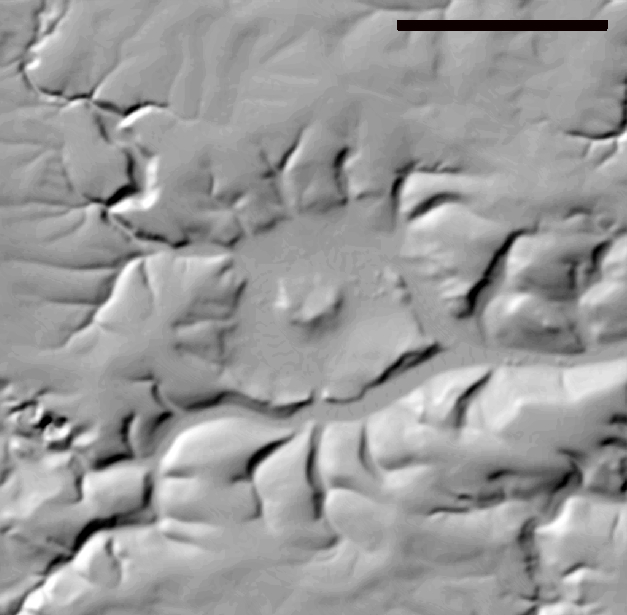
Fig. 1. Relief map of the Steinheim Basin crater. Scale bar 3 km. (Source : TOP 25 Baden Württemberg).
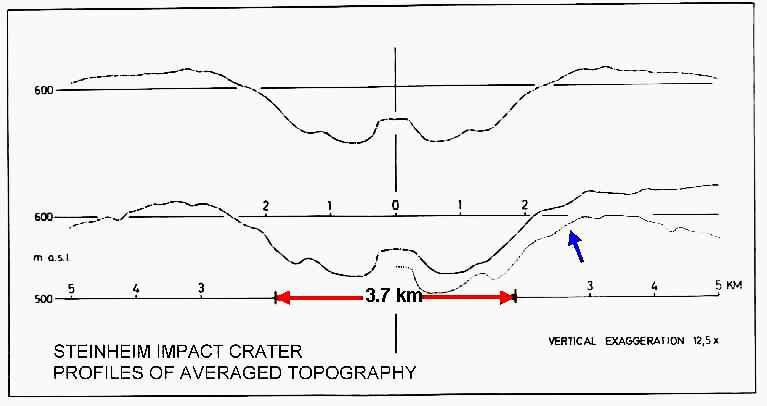
Fig. 2. Profiles of averaged topography of the Steinheim crater. Top profile: Averaged topography based on 32 radial profiles. Bottom profile: Averaged topography from 16 southern (to the left) and 16 northern (to the right) stacked profiles. Dotted line: Left-hand profile mirrored at the zero axis and shifted vertically 20 m. The 3.7 km bar matches to the average rim crest diameter according to Roddy (1977).
It is interesting to note that the Steinheim impact structure, which is shown to be about twice as large, fits nicely into a new concept of the structural makeup of complex impact structures when an explanation for the conspicuous drainage system is sought as shown in Figs. 3, 4.
Transpression and transtension are strike-slip deformations that deviate from simple shear, when a component of shortening or extension orthogonal to the deformation zone occurs. These three-dimensional non-coaxial strains develop principally in response to obliquely convergent or divergent relative motions. For complex impact structures, Kenkmann and Dalwigk (2000) have shown that such deformations can be a new and noteworthy feature that arises in the modification phase of impact cratering during converging and diverging gravitational collapse movements.
A very simple model of these strike-slip deformations has been sketched in Fig. 4, which should serve to classify the very unusual morphological conditions in the Steinheim area (Fig. 3).
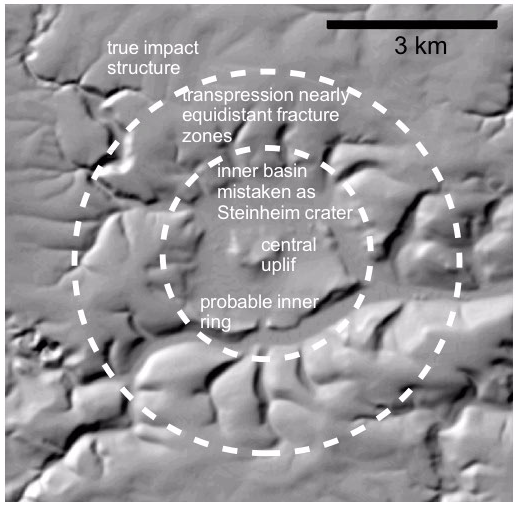
Fig. 3. Interpretation of the morphological signature of the Steinheim impact structure (see text).
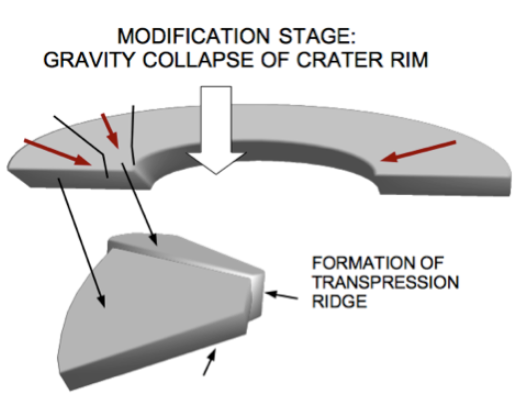
Fig. 4. Simple model of strike-slip transpression structures in complex impact craters.
With the formation of transpression ridges during the collapse of the outer rim of the primary transition crater with the convergence towards the crater center, it becomes understandable that more or less wide fracture zones were formed between the separating blocks, which in the course of the following ca. 15 Mill. years were predestined for the drainage system observed today.
That this structural system of transpression cannot be mapped as in the Siljan and Decaturville structures (Kenkmann and Dalwigk (2000) is very easy to explain. More or less the complete ring zone of the radial drainage with the expected fracture zones is located in dense forest areas, where also the relatively uniform facies of the thick Malmian carbonate rocks does not allow a significant mapping differentiation.
In summary and with a view to Fig. 3, the following inventory results for the Steinheim Basin: We are dealing with a complex impact structure with an outer rim diameter of about 7-8 km. Apart from the central uplift, which has always been obvious, the beginnings of the formation of an inner ring can be stated. In the modification stage of crater formation, the large transient crater, possibly in combination with central elastic rebound, collapsed with the formation of central uplift and inner ring. During the collapse of the transient crater, which is order of magnitude 7-8 km in diameter, the formation of relatively radially symmetric transpression ridges produced the peculiar drainage system now visible in the Digital Terrain Model.
Even in the graphical log-log compilation of Fig. 5, the Steinheim crater, which is twice as large, fits in much better.
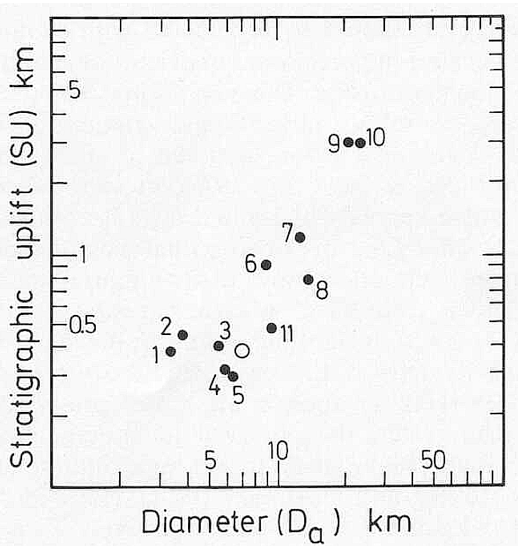
Fig. 5. Stratigraphic uplift/diameter relationship for terrestrial impact structures, sedimentary target. 1 = Steinheim, 2 = Flynn Creek, 3 = Crooked Creek, 4 = Middlesboro, 5 = Serpent Mound, 6 = Red Wing Creek, 7 = Sierra Madera, 8 = Wells Creek, 9 = Gosses Bluff, 10 = Strangways, 11 = Kilmichael (possible impact origin, Huber et al. 2013). After Grieve et al. (1981). Open circle: Steinheim crater according to the larger true diameter.
2.3 Gravity survey
The starting point for the new model of the Steinheim Basin by Ernstson (1984) were the very extensive gravimetric measurements with a network of about 500 measuring stations. In connection with the morphological analysis, they clearly proved the roughly twice as large impact structure with detailed comparisons to the Ries crater. Here we limit ourselves to the essential results of this gravimetry campaign and refer in the remainder to the original article by Ernstson (1984).
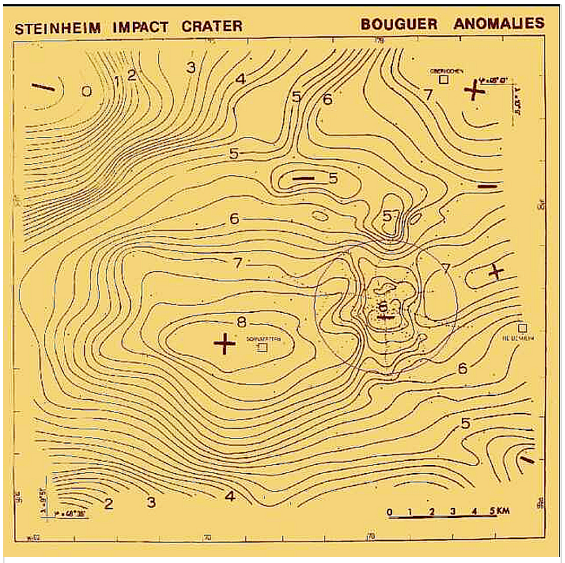
Fig. 6. Bouguer gravity map of the Steinheim Basin area (encircled) and its surroundings. Contour interval 0.25 mGal.
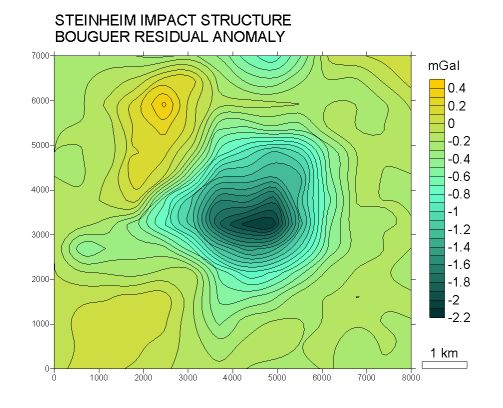
Fig. 7. Bouguer residual anomaly of the Steinheim impact structure. Contour interval 0.1 mGal.
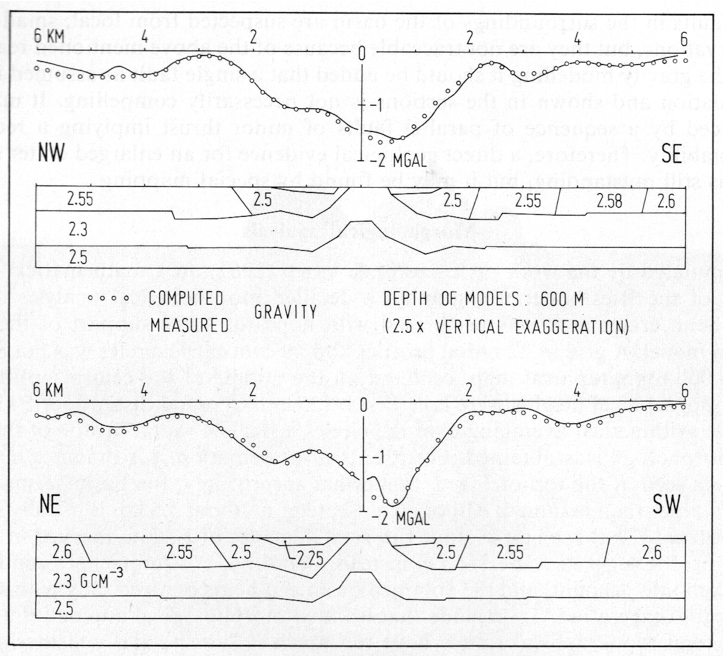
Fig. 8. Model calculations. Densities for the model bodies are in g/cm3.
3 Conclusions
The authors’ attempt, enriched with 74 literature citations, to question the simultaneity of the Ries and Steinheim Basins as a paired impact and to postulate a geologically “fright second” of only a few 10,000 years between the two events only 40 km apart is legitimate, as long as alternative solutions are duly considered. This is missed when normal earthquake seismites and volcanism in general are discussed in detail, but the earthquake activity of the literally nearby earthquake zone of the Rhine Valley Rift System, already active in the Miocene, is not mentioned at all, especially since the severe earthquake of Basel at the same distance and with the same magnitude is in no way inferior to the Steinheim impact.
As a result, the article loses its fundamental significance to the point of the simple alternative: it may be, but it also may not be, and a finding particularly worth mentioning for impact research cannot be recognised. Here one is therefore inclined to attest to the co-authors Buchner and Schmieder once again that the wish was father to the thought, just as we pointed out at the beginning that the alleged suevite in the Steinheim Basin is not a suevite, the alleged lack of ejecta masses is based on completely false premises and considerable ignorance, and the alleged pallasite fragment of the Steinheim projectile cannot be explained by any impact cratering process.
References
Buchner, E. & Schmieder, M. (2010) Steinheim Suevite—a first report of melt bearing impactites from the Steinheim Basin (SW Germany). Meteorit. Planet. Sci. 45, 1093–1107.
Buchner, E. & Schmieder, M. (2015)The Steinheim Basin impact crater (SW-Germany)—where are the ejecta?. Icarus 250, 529–543.
E. Buchner, E., M. Hölzel, M., Schmieder, M., Rasser, M., Fietzke, J., Frische, M., Kutterolf, S. (2017). A METEORITE FRAGMENT TRAPPED BETWEEN POSITIVE AND NEGATIVE SHATTER CONES IN A LIMESTONE BLOCK STORED AT THE METEORKRATER-MUSEUM STEINHEIM, GERMANY. – 80th Annual Meeting of the Meteoritical Society 2017, Abstract 6014.pdf.
Buchner, E., Sach, V.J. & Schmieder, M. New discovery of two seismite horizons challenges the Ries–Steinheim double-impact theory. Sci Rep 10, 22143 (2020). https://doi.org/10.1038/s41598-020-79032-4
Ernstson, K. (1984) A gravity-derived model for the Steinheim impact structure. International J. Earth Sci., 73/2, 483-498).
Ernstson, K. (2011) No Steinheim suevite. – https://www.impact-structures.com/meteorite-impact-germany/the-steinheim-basin-impact-structure/no-steinheim-basin-suevite/
Ernstson, K. (2015) “The Steinheim impact crater – where are the ejecta?” Critical comment on the Buchner & Schmieder paper. – https://www.impact-structures.com/meteorite-impact-germany/the-steinheim-basin-impact-structure/the-steinheim-impact-crater-germany-where-is-the-ejecta-blanket-comment-on-the-buchner-schmieder-paper/
Ernstson, K. (2017) The Steinheim Basin meteorite crater, the meteorite and the alleged pallasite impact projectile: wishful thinking or scientific sobriety? (in German) – http://www.impaktstrukturen.de/2017/09/neues-aus-der-welt-der-impaktstrukturen-meteoritenkrater-und-verwandter-themen-folge-5-der-meteoritenkrater-steinheimer-becken-und-das-angebliche-pallasit-projektil-wunschdenken-oder-wis/
GRIEVE, R. A. F., ROBERTSON, P. B. & DENCE, M. R. (1981) Constraints on the formation of ring impact structures, based on terrestrial data. – In: Multi-ring Basins (P. H. Schultz and R. B. Merrill, eds.), Proc. Lunar Planet. Sci., 12 A, 37–57, Pergamon Press, New York.
Hofmann F (1973) Horizonte fremdartiger Auswürflinge in der ostschweizerischen Oberen Süsswassermolasse und Versuch einer Deutung ihrer Entstehung als Impakt-Phänomen. – Eclogae Geol Helv 66:83–100.
Hofmann F (1978) Spuren eines Meteoriteneinschlags in der Molasse der Ostschweiz und deren Beziehung zum Riesereignis. – Bull Ver Schweiz Pet-Geol Ing 44:17–27
Hofmann F (1978) Spuren eines Meteoriteneinschlags in der Molasse der Ostschweiz und deren Beziehung zum Riesereignis. – Bull Ver Schweiz Pet-Geol Ing 44:17–27
Hofmann F (1978) Spuren eines Meteoriteneinschlags in der Molasse der Ostschweiz und deren Beziehung zum Riesereignis. – Bull Ver Schweiz Pet-Geol Ing 44:17–27.
Huber, M.S., et al. (2013) Revisiting Kilmichael (Mississippi), a possible impact structure. – 44th Lunar and Planetary Science Conference (2013), Abstract 2250.pdf
Ivanov, B.A. and D. Stöffler (2005): THE STEINHEIM IMPACT CRATER, GERMANY: MODELING OF A COMPLEX CRATER WITH CENTRAL UPLIFT. – Lunar and Planetary Science XXXVI, Abstract 1443.pdf.
Kenkmann, T. & Dalwigk, I. von (2000): Radial transpression ridges: A new structural feature of complex impact craters. Meteoritics & Planet. Sci., 35, 1189-1201.
RODDY, D. J. (1977) Tabular comparisons of the Flynn Creek impact crater, United States, Steinheim impact crater, Germany and Snowball explosion crater, Canada. – In: Impact and Explosion Cratering (D. J. Roddy, R. O. Pepin, and R. B. Merrill, eds.), 125–162, Pergamon Press, New York.
Stöffler, D., Artemieva, N.A. and Pierazzo, E. (2002): MODELING THE RIES-STEINHEIM IMPACT EVENT AND THE FORMATION OF THE MOLDAVITE STREWN. Lunar and Planetary Science XXXIII (2002), Abstract 1871.pdf.






































































